http://www.chemistrymag.org/cji/2003/057058pe.htm |
Jul. 1, 2003 Vol.5 No.7 P.58 Copyright |
(1Department of Chemistry, Shantou University, Shantou 515063, China; 2Institute of Polymer Science, Zhongshan University, Guangzhou 510275, China)
Received May 19, 2003. Supported by the National Natural Science Foundation of China (No.20274023), National Ministry of Education of China (No.02114) and Guangdong Provincial Natural Science Foundation (No.021241)
Abstract The surface modification by the
photografting of r-HALS (reactive hindered amine light stabilizer) on a commercial
polyolefin thin film was studied. The process proceeded by photo-initiated grafting
copolymerization of 4-methacryloyloxy-1,2,2,6,6-pentamethyl-piperidine (MPMP), a reactive
HALS, onto the surface of linear low density polyethylene(LLDPE) thin film, presoaked in
the benzene solution containing benzophenone (BP) initiator and MPMP monomer and UV
irradiation for short time under nitrogen atmosphere. All measurements of the grafted
polymer surface, such as relative intensity (R.I.) of ESCA lines C1S, O1S,
or N1S, and Carbonyl Value (CV) or R.I. of FTIR-ATR spectral lines of carbonyl
absorbance of MPMP, and the Yellowness Index (YI) of grafted LLDPE film have been
performed. The grafting yield of MPMP onto the surface of LLDPE film was calculated by the
weight gain of the sample after irradiation. The results show that the increase of
carbonyl absorbance (or CV) was in line with the concentration of MPMP monomer in the
presoaking solution, the grafting yield and the irradiating time. The N1s
signals in ESCA spectra of the grafted LLDPE surface clearly indicates that photo-grafted
copolymerization has taken place and a distinct grafted layer on the surface produced.
Yellowness Index (YI) of the grafted LLDPE films is much lower than that of the blank film
through the 4500 hours photo-oxidation, an evidence for improvement of the
photo-stability. Surface modification of LLDPE film by photo-grafted with r-HALS monomer
has thus been proved efficient for the photostabilization of LLDPE.
Keywords surface modification, photografting, photostabilization, r-HALS, LLDPE
film
1. INTRODUCTION
Polyolefin resin have been applied as one of the
most useful polymer materials by virtue of many merits, but photo-oxidative degradation of
the polymer directly affects the service life in outdoor application, which limits its
usability. Mechanism of photo-oxidative degradation caused by radical formation induced by
UV irradiation has been studied and it is found that the photo-oxidizing process mainly
undergoes at the surface of polymer materials [1-4]. It is well known that the
surface properties of polyolefin thin film, such as the surface energy, the surface
polarity and the surface hardness etc. could be modified by photochemical grafting [5-7].
Up to now, hindered amine light stabilizers (HALS) as the most effective light stabilizers
have been widely applied to photostabilization of polyolefin resin and thin film [8].
One current trend is to use higher molecular weight HALS for enhancing thermal
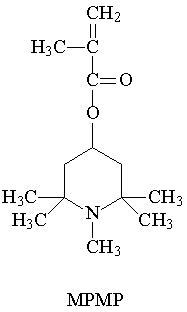
2. EXPERIMENTAL
2.1 Materials and instruments
A linear low density polyethylene (LLDPE) thin film with crystallinity of 38 % and without additives was used in this study. The average thickness of the film was 26.2 mm as measured by an A-528 micrometer with a sensitivity of 10-2 mm. The sample films were weighed on a micro photo-electronic balance TG 332-A with an accuracy of 0.01 mg. 4-methacryloyloxy-1,2,2,6,6-pentamethyl-piperidine (MPMP) was synthesized and characterized in our lab[9]. MPMP is a light yellow liquid with b.p.= 95-97ºC/3-4 mmHg. Benzophenone (BP) was re-crystallized twice from benzene/ethanol. Other reagents used such as acetone, benzene and ethanol etc., were analytical grade, and purified by distillation before use. Infrared analysis was carried out on a Nicolet Magna-IR750 Fourier transform infrared spectrometer(FTIR). The ESCA spectra were recorded on an ESCALab MK2 spectrometer by XPS technique with a MgKa source, step= 0.05.
2.2 Preparation of presoaking solution
MPMP and BP initiator were accurately weighed and dissolved in toluene to prepare presoaking solution with different concentration. The composition of the presoaking solution was given in Table 1. At ambient temperature, the presoaking solution was kept overnight in dark place for homogenization. The sample films of LLDPE with 3×4 cm2 were extracted with acetone in an extractor, dried to constant weight. The sample film was immersed in the presoaking solution for 12 hours.
Table 1. The composition of presoaking solution used for photo-grafting of LLDPE film
|
0 |
10.07 |
19.39 |
30.02 |
40.13 |
|
0 |
2.48 |
2.48 |
2.49 |
2.48 |
2.3 Photo-grafting procedures
The sample film after immersion was placed between two quartz plates to stretch
smoothly, and then placed into the grafting "box" with a quartz window. The sample film was exposed in the presence
of nitrogen to the UV radiation on a caterpillar UV-curing machine at a conveyor speed of
92 cm/min. The central intensity of the medium-pressure mercury lamp (2400 W) was 198
mW/cm2, the main emission line of the lamp was 365 nm and the effective arc
length was 20 cm. The light intensity was measured by an UV-radiometer (type UV-A, made by
Beijing Normal University Photoelectric Instrument Factory), which is sensitive in the
wavelength range of 320-400 nm. The sample films after irradiation were immersed in the
solution with acetone for 12 hrs and extracted intensively to remove unreacted monomer and
homopolymer. The sample film was weighed after drying.
2.4 Photooxidation
The sample film grafted was irradiated with a mercury-arc lamp (GZ-500W), in air at 25ºC which was
constantly controlled by flowing. UV irradiation of l< 300 nm was filtrated by a Pyrex glass. The coloration of the
sample film was characterized with Yellowness Index measured on a UV-Vis spectrometer
(Model 723, Shanghai analytical instrument plant). Yellowness index was calculated by the
following equation (ASTM, D1925):
![]()
where T420, T560,
T680 are the transmittance of the sample films before photo-oxidation
at the wavelength of 420, 560 and 680 nm respectively; T'420 and T'680 are the transmittance of the sample film when the
exposure time of photo-oxidation equal to t at the wavelength of 420 and 680 nm
respectively.
3. RESULTS AND DISCUSSION
3.1 Grafting ratio of MPMP
The grafting ratio c was calculated according to Eq. (2):
![]()
Where W0 is the
original weight of the sample film before grafting; Wt is the
weight of the film after grafting.
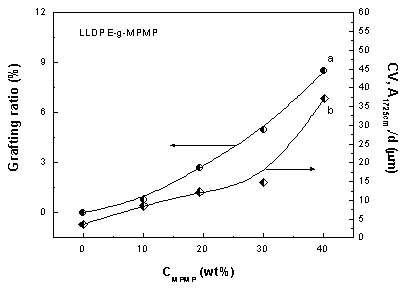
Figure 1. The grafting ratio and Carboxyl
Value (CV) changing with monomer concentration in the presoaking solution
Using benzophenone as a photoinitiator (WPI =
2.48 %), light intensity is 1.43 mW/cm2, irradiation time is 10 min.
Carbonyl Value (CV) was
defined as the carbonyl absorbance![]() from the
FTIR spectra of the grafted film divided by the thickness of film (d, m
from the
FTIR spectra of the grafted film divided by the thickness of film (d, m
The grafting ratio and CV of the sample film grafted increased with the monomer concentration in the presoaking solution as shown in Figure 1.
Figure 1 shows that when the irradiation time was 10 min, with the increasing of the monomer concentration in the presoaking solution, CV tends to increase in synchronism with the grafting ratio of the grafted film. In FTIR-ATR spectra, the carbonyl absorption (1750 cm-1) of the grafted film appears and increases with the irradiation time (Fig. 2), which is an evidence of the grafting of MPMP monomer onto the surface of LLDPE film although there is small absorption of carbonyl group on the surface of blank film due to oxidation occurring during the presoaking process. Grafting ratio of LLDPE with MPMP may be roughly estimated from the carbonyl values obtained by FTIR-ATR spectrum.
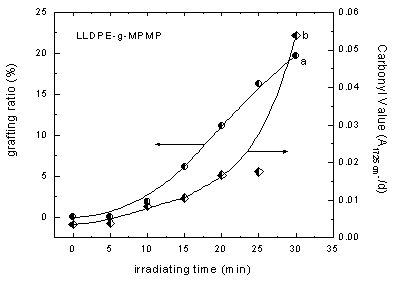
Figure 2. The variation of grafting ratio and CV with irradiation time
Using benzophenone as a photoinitiator (WPI = 2.48 %), the concentration of MPMP monomer in the presoaking solution is 40.13 wt%, light intensity is 1.43 mW/cm2.
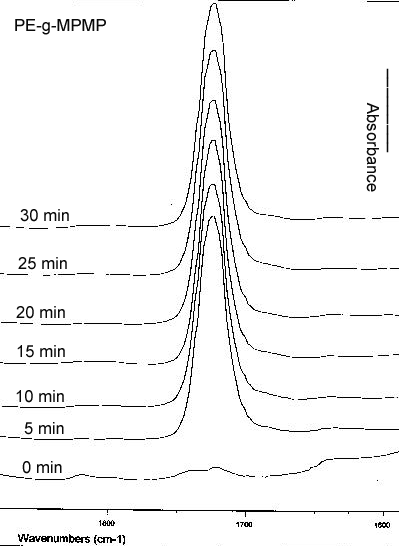
Figure 3. Effect of irradiation time on carbonyl absorbance on the surface of LLDPE film grafted with MPMP.
Using benzophenone as a photoinitiator (WPI = 2.48 %), the concentrations of MPMP in the presoaking solution is 40.13 wt%.
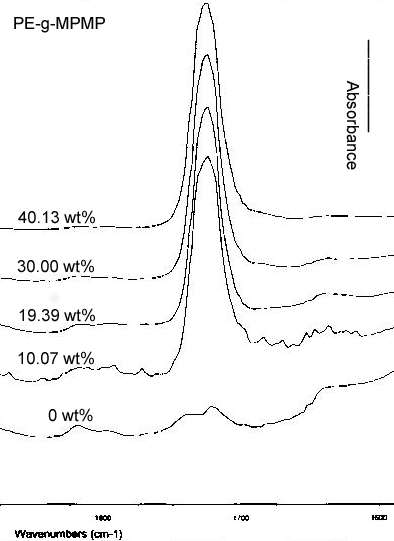
Figure 4. Effect of monomer concentration in the presoaking solution on carbonyl absorbance on the surface of LLDPE film grafted with MPMP.
Using benzophenone as a photoinitiator (WPI = 2.48 %), the irradiation time is 10 min.
3.2 Characterization of the
grafted film by FTIR-ATR and ESCA
The results of FTIR-ATR (Fig. 3-4) and ESCA (Fig. 5-8) spectra of the grafted film have
further shown that MPMP was successfully grafted onto the surface of the polymer substrate
under UV irradiation. Fig. 3 and 4 show that CV of the sample film (line b in Fig. 1 and
2) increase with the concentration of MPMP monomer in the presoaking solution and the
irradiation time respectively. The data listed in Table 2 indicate that at an irradiation
time of 25 min, both grafting ratio and CV reach up to maximum values of 11.63 wt% and
0.0497, respectively. Thereafter both parameters tend to decrease slowly. It is clear that
the grafting coplymerization of LLDPE film with MPMP monomer has been terminated at that
time. The results obtained from ESCA spectra are in accordance with that from FTIR-ATR
spectra.
Figure 5 shows ESCA spectra of LLDPE film, both grafted and blank, at
different concentration of MPMP in the presoaking solution. The characteristic peaks of C1s,
O1s and N1s changed with increasing of concentration of MPMP. For
detailed structural analysis the peaks of C1s, O1s and N1s
in Fig. 5 are amplified and shown separately in Figs. 6-8.
In Fig. 6, a shoulder peak of C1s
(around 288 eV) appears at higher concentrations of MPMP, this peak is ascribed to
carbon atoms from -C-O- and carbonyl groups,
which demonstrates that the monomer has been successfully grafted onto the polymer surface
by photo-grafting copolymerization.
Relative intensity (R.I.) and the area of C1s peaks decrease
with the increment of MPMP concentration owing to the grafted MPMP onto the polymer
substrate, meanwhile the ratios of N1s/C1s and O1s/ C1s
increased clearly. It can be seen from Figs. 7 and 8 that with the increasing of MPMP
concentration in the presoaking solution, both O1s peak (at 530 eV) and N1s
peak (at 398 eV) appear and increase remarkably. The above results further
demonstrate that MPMP can be successfully grafted onto the surface of LLDPE film by
UV-induced copolymerization using BP as an initiator.
Table 2. Variation of CV and grafting ratio with irradiation time by
photo-grafting of MPMP on LLDPE film
Irradiation time |
LLDPE-g-MPMP |
|
Grafting ratio (%) |
CV (A1725 cm-1/mm) |
|
0 |
0.00 |
0.0036 |
5 |
7.20 |
0.0357 |
10 |
8.50 |
0.0372 |
15 |
9.84 |
0.0373 |
20 |
11.02 |
0.0400 |
25 |
11.63 |
0.0497 |
30 |
10.50 |
0.0326 |
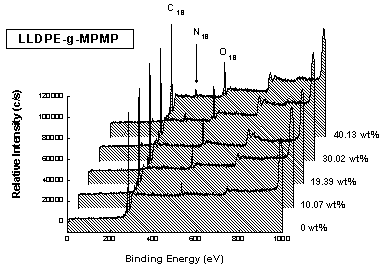
Figure 5. ESCA spectra of the surface of LLDPE film photo-grafted with MPMP
Using benzophenone as a photoinitiator (WPI = 2.48 %), the irradiation time is 10 min. Concentrations of MPMP in the presoaking solution. changed from 0 to 40.13 wt%
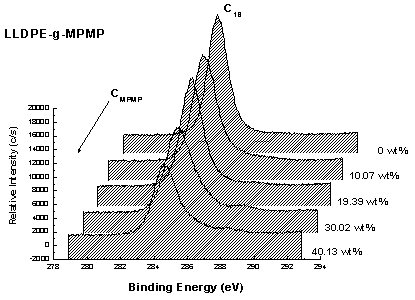
Figure 6. ESCA spectra of C1s on the surface of LLDPE film photo-grafted with MPMP
Using benzophenone as a photoinitiator (WPI = 2.48 %), the irradiating time is 10 min. Concentrations of MPMP in the presoaking solution. changed from 0 to 40.13 wt%
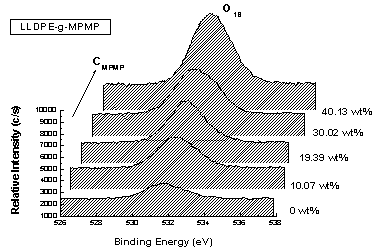
Figure 7. ESCA spectra of O1s on the surface of LLDPE film photo-grafted with MPMP
Using benzophenone as a photoinitiator (WPI = 2.48 %), the irradiating time is 10 min. Concentrations of r-HALS monomer are changed from 0 to 40.13 wt% in the presoaking solution. Irradiating time is 10 min.
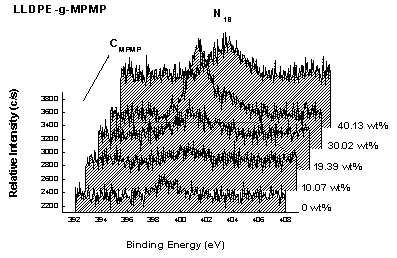
Figure 8. ESCA spectra of N1s on the surface of LLDPE film photo-grafted with MPMP
Using benzophenone as a photoinitiator (WPI = 2.48 %), the irradiating time is 10 min. Concentrations of r-HALS monomer in the presoaking solution. changed from 0 to 40.13 wt%
3.3 The photo-stabilizing performance of LLDPE-g-MPMP film
The photo-stabilizing performance of LLDPE-g-MPMP film during the photo-oxidation aging by UV exposure up to 4500 hours is shown in Fig. 9. Yellowness index (YI) of blank film showed a rapid increase after UV exposure time of 3000 hours and the film changed to very brittle. Although photo-oxidation degradation mechanism of photo-grafting surface is similar to that of other in terms of chemical route, but there are different details because HALS completely distributes throughout the polymer surface and chemically bonded with each other. Therefore, the multi-layers of HALS with functional bonds such as piperidine ring on photo-grafting surface layer are regularly arranged and form excellent protecting layer against photo-aging. This effect is especially manifested as the >N-CH3 in the piperidine ring could be quickly transferred to >N-O· during the photo-grafting procedure or at the early stage of photo-oxidation. The fact that the >N-CH3 in the piperidine ring can be quickly transferred to >N-O· has been proved in the study on the reaction kinetics of photo-induced polymerization of r-HALS in detail[11].
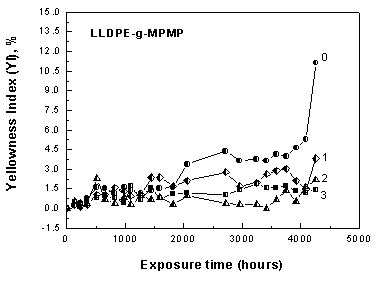
Figure 9. Photo-stabilization of LLDPE film photo-grafted with MPMP
The concentration of MPMP in the presoaking solution is 10.07 wt% (line-1), 19.39 wt%(line -2) and 30.02 wt% (line 3) respectively, and line 0 is the blank.
Figure 9 shows that Yellowness index (YI) of the sample film changed with the exposure time. After the 1800 hours, YI of the blank began to increase quickly, in contrast to the grafted film which was still under lower coloration level. Better photo-stabilizing performance is obtained when higher MPMP concentration in the presoaking solution is used.
4. CONCLUSION
Surface modification of linear low density polyethylene (LLDPE) thin film by the
method of photo-grafting copolymerization of MPMP (r-HALS) has been studied. Effects of
monomer concentration in the presoaking solution and the irradiation time on the grafting
ratio of LLDPE film were investigated by FTIR-ATR and ESCA spectra. All measurements of
the grafted polymer surface, such as relative intensity (R.I.) of ESCA lines of C1S,
O1S or N1S, and Carbonyl Value (CV) or R.I. of FTIR-ATR spectral
lines of carbonyl absorbance of MPMP, and the Yellowness Index (YI) of grafted LLDPE film
were performed. The results show that the carbonyl absorbance (or CV) increases in line
with the concentration of MPMP monomer in the presoaking solution, the grafting ratio and
the irradiation time. The N1s signals in ESCA spectra of the grafted LLDPE
surface clearly indicated that photochemical-grafted copolymerization has taken place and
a distinct grafted layer produced on the surface of the LLDPE film. After grafting, the
surface properties, especially photostability, is substantially improved. Surface
modification of LLDPE film by photo-grafting of r-HALS monomer is an effective way to
improve the photostability of LLDPE film.
REFERENCES
[1] Piletsky S A, Matuschewski H, Schedler U. Macromolecule., 2000, 33: 3092-3098.
[2] Allen N S, Segurola J, Edge M, et al., Surface Coatings International., 1999, b:
285-292.
[3] Rånby B. Polym. Eng. Sci., 1998, 38: 1229-1243.
[4]Decker C. Prog. Polym. Sci., 1996, 21: 593-650.
[5] Shentu B Q, Zhao L, Weng Z X, et al., Polymer Bulletin. (in Chinese), 2001, 1: 24-30.
[6] Yang W T, R?nby B. Polymer Bulletin., 1996, 37: 89-96.
[7] Decker C. J. Appl. Polym. Sci., 1983, 28: 97-107.
[8] Liu X X, Chen Y L. Polymer Bulletin (Gaofenzi Tongbao), 1999, 4: 57-66.
[9] Liu X X, Yang J W, Chen Y L. Polym. Adv. Technol., 2002, 13(3): 247-253.
[10] Liu X X, Yang J W, Huang J T, et al., J. Funct. Polym. (Gongneng Gaofenzi Xuebao),
2001, 14(4): 387-392.
[11] Liu X X, Wu G G., Chen Y. Chem. Research in Chinese Univ., 2002, 18(3-4): 159-160.
刘晓暄a,b*,解令海a,张伟群a,徐严平a,吴光国a,庞来兴b,杨建文b,曾兆华b,陈用烈b
(a汕头大学化学系,汕头515063;b中山大学高分子研究所,广州510275,中国)
摘要 本文以二苯甲酮(BP)为光引发剂,成功地实现了反应型受阻胺光稳定剂(r-HALS),4-甲基丙烯酰氧基-1,2,2,6,6-五甲基哌啶醇酯(MPMP)对LLDPE薄膜的液-固相光接枝共聚合的表面改性,并采用红外(FTIR-ATR)和电子能谱(ESCA)对光接枝过程进行了监测和表征。研究结果表明:接枝率(称重法)对辐照时间和对单体溶液浓度呈准线性增长关系;光接枝后LLDPE膜的表面羰基指数(CV)随着样品膜的表面接枝率、预浸液的MPMP单体浓度和辐照时间的增加呈同步增长关系;光接枝后LLDPE膜的表面电子能谱(ESCA)中的C1S、O1S和N1S谱线的相对衍射强度(R.I.)与羰基指数(CV)呈同步变化规律:C1S衍射峰的R.I.逐步降低,而O1S和N1S衍射峰的R.I.逐步升高。改性后LLDPE膜的变黄指数(YI)在历经4500小时的光氧化实验后明显低于空白膜,这表明r-HALS的表面光接枝是提高薄膜光稳定性能的有效方法。
关键词 表面改性 反应型受阻胺(r-HALS) 光接枝 LLDPE 光稳定化